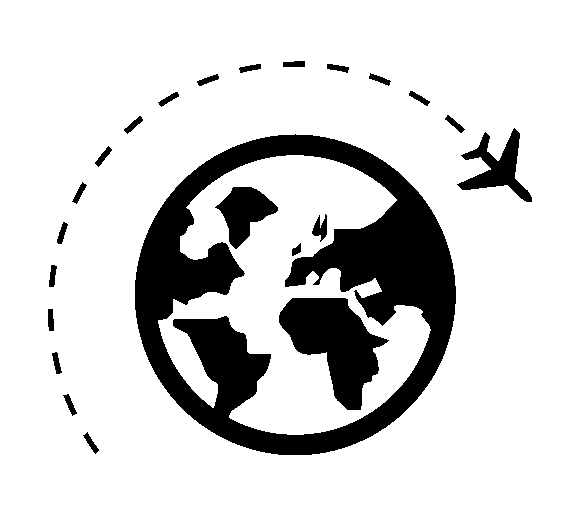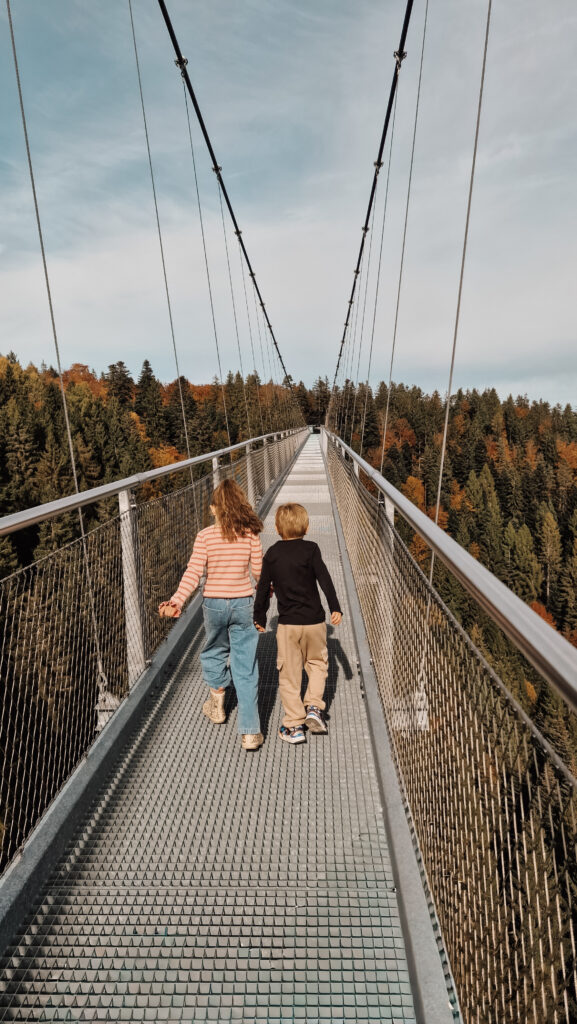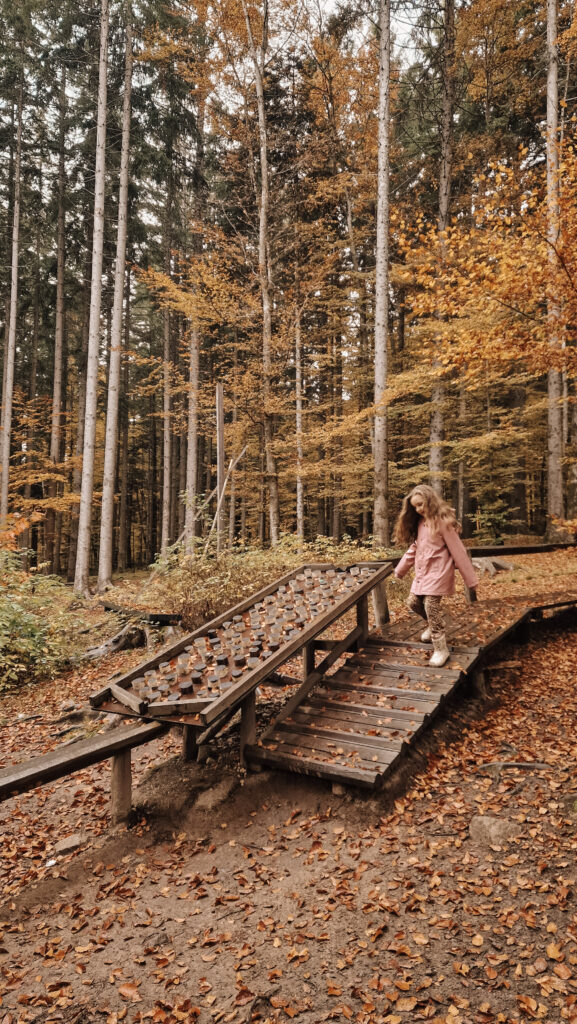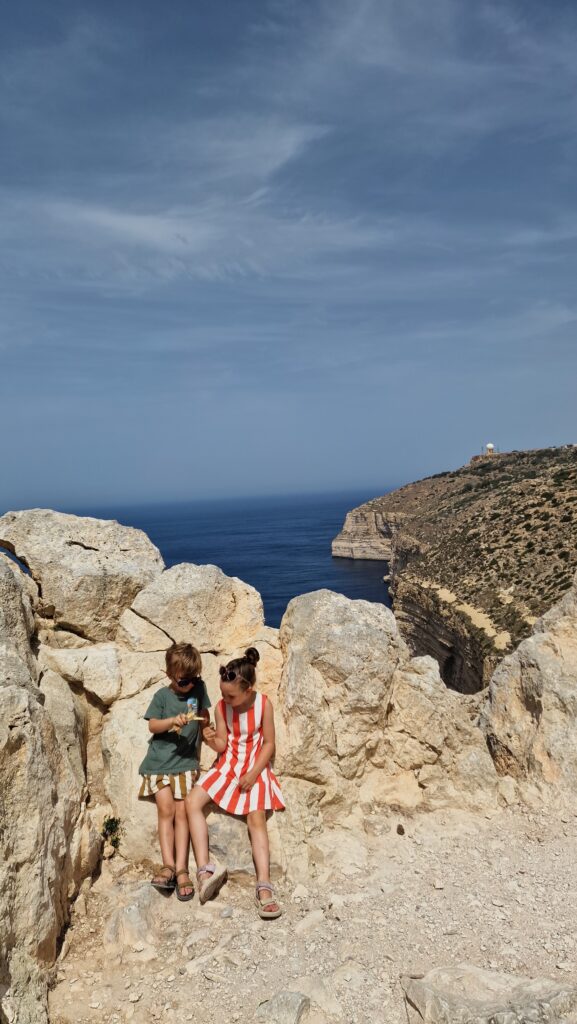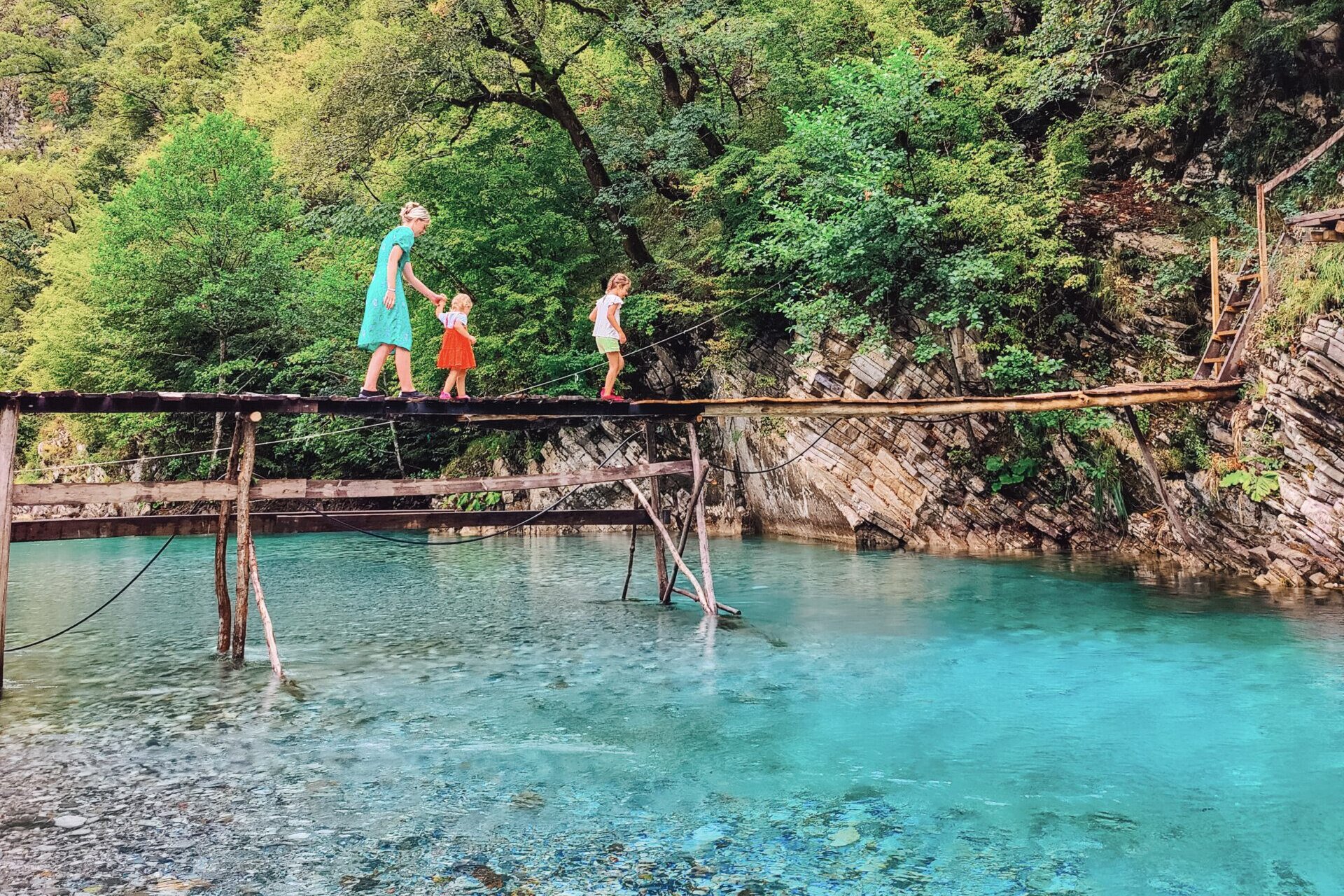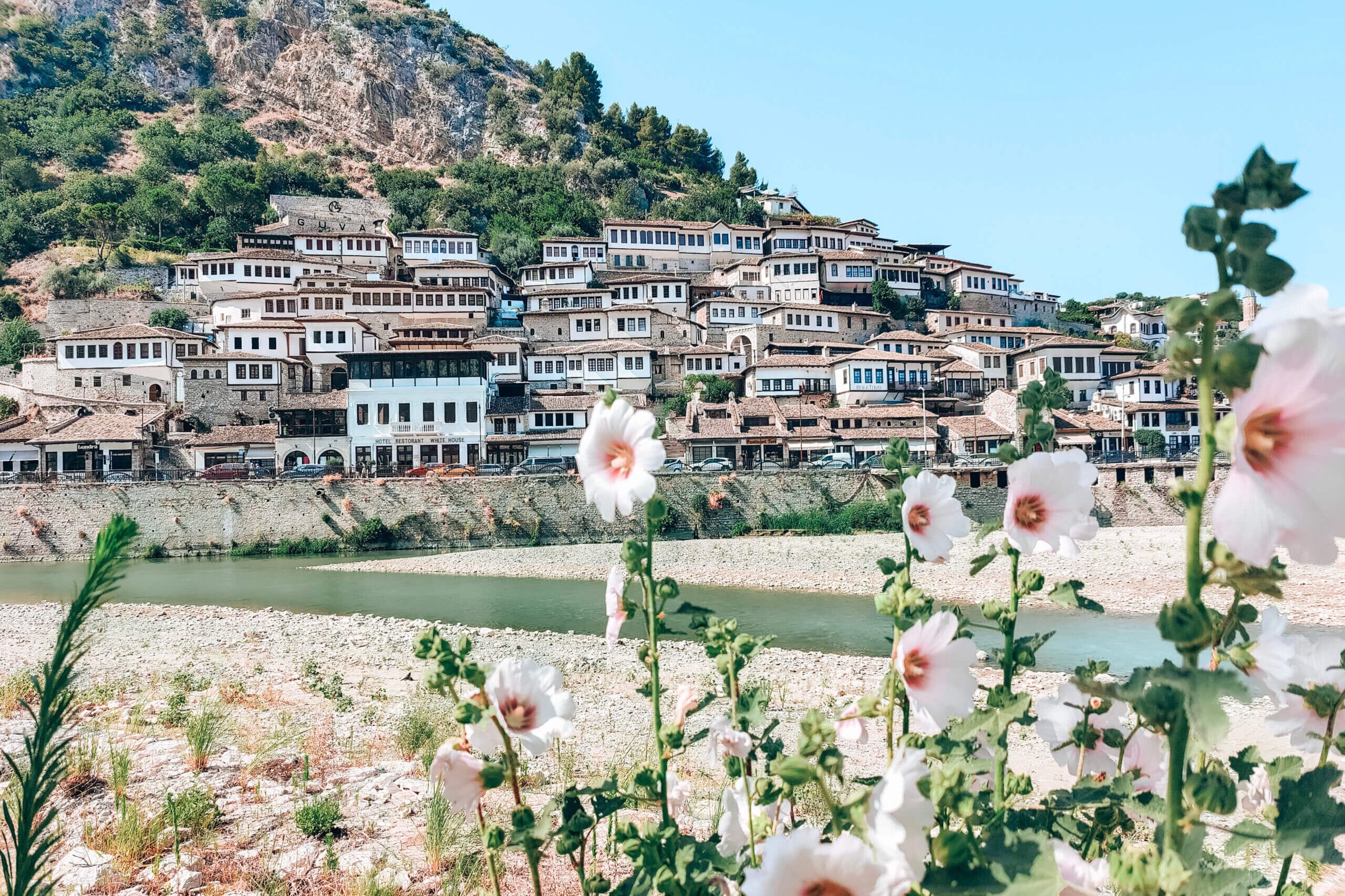Road trip through Malaysia with children
Route & tips for an unforgettable trip
In this blog, you will find all our tips for an unforgettable and beautiful round trip through Malaysia with children.
Our dream is to travel to all continents with our girls. Enna is 10 and Zara is 12 when we venture to Asia with them for the first time. Just the two of us have previously traveled in Thailand and Indonesia, and we choose Malaysia because it is a well-developed country and Borneo is appealing. You can easily drive around the country by car, and it has good healthcare.
Malaysia has a population of 33 million, with Kuala Lumpur as its capital and Islam as the predominant religion. The country consists of two parts: the Malay Peninsula, which borders Thailand, and the northern part of the island of Borneo. Borneo is the third-largest island in the world and is divided among three countries: Malaysia, Indonesia, and the small state of Brunei.
We found the people to be very warm, polite, and curious about us. Countless selfies were taken by Malaysians with our girls…
This blog is written by Stephanie.
🌞 Search & Book Your Family Holiday to Malaysia with Kids
✅ Family-friendly hotels, apartments & resorts
💙 Book directly with Booking.com – trusted & easy
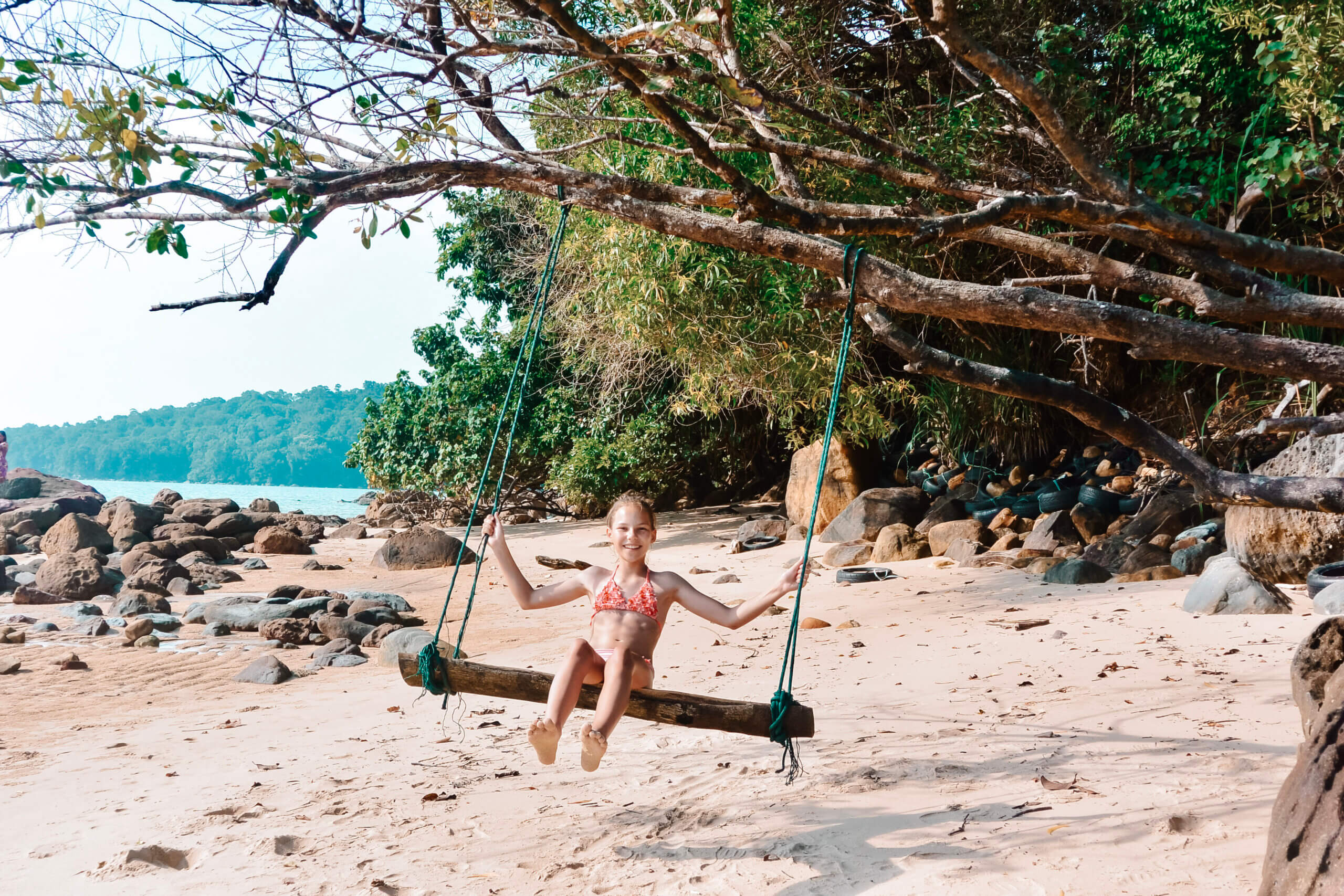
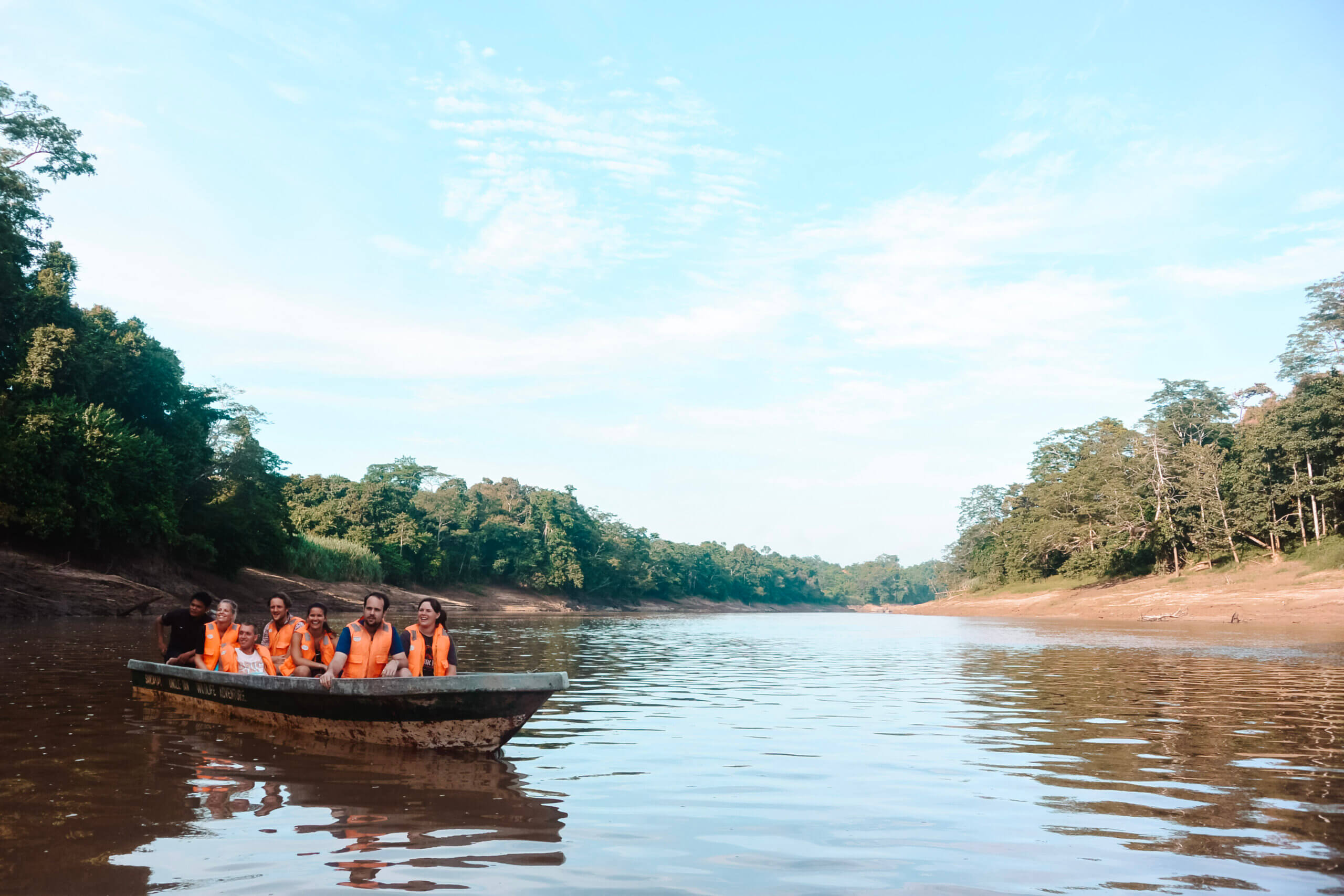
General Information for a Family Trip through Malaysia
Rainy Season
The mainland of Malaysia has two different rainy seasons. On the west coast, the heaviest rainfall occurs from September to December, while the east coast experiences its rainy season from November to March. The dry season on the east coast coincides with our European summers, which is ideal. Borneo has a drier season during our summer, although a rain shower can always occur.
Flight Duration
We flew from Schiphol to Kuala Lumpur, with a layover in Hong Kong. Expect to be traveling for about 16 hours. The domestic flights (Air Asia) are convenient and affordable, and we arranged them in advance.
Health
In terms of healthcare, Malaysia is a well-developed country. We had the girls vaccinated against hepatitis A (we were already fine). Malaria is only present in the deep jungle of Borneo, and we took malaria pills with us just to be safe.
Rental Car
We arranged both rental cars through Rental Cars, and the prices are about the same as what you would pay in Europe. The roads are good and modern. Make sure to have an international driver’s license, and yes, they drive on the left! It takes some getting used to…
Accommodations
We slept in a variety of fantastic places: a skyscraper apartment in the capital, guesthouses, an eco-resort in the rainforest, a beach bungalow, a treehouse in Borneo, and stilt huts during the wildlife safari. You can easily book accommodations through Booking.com.
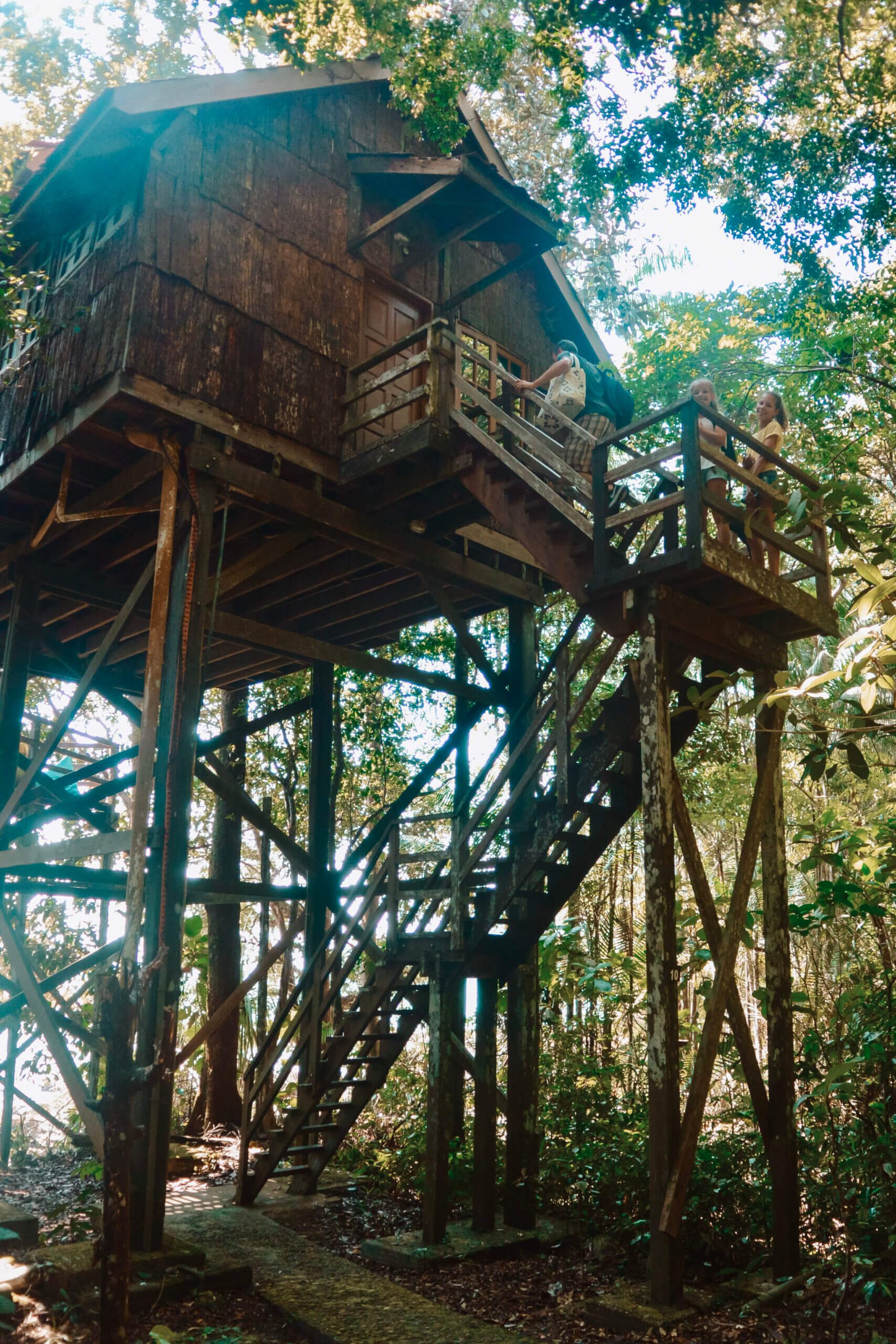
Our itinerary during our family tour of Malaysia with kids
We were on the road for a total of 4 weeks. We started our trip in the capital, Kuala Lumpur, and drove through the world’s oldest rainforest and the tea plantations of the Cameron Highlands to the east coast. We checked in for a 6-day snorkeling adventure on the Perhentian Islands.
Then we flew to Malaysian Borneo, where we primarily sought wildlife and jungle experiences. We slept in a treehouse among the monkeys in Sarawak and went on a wildlife safari in search of orangutans in Sabah. But there was also time for beautiful beaches and relaxation in Borneo.
Finally, Hong Kong was on the itinerary as a stopover.
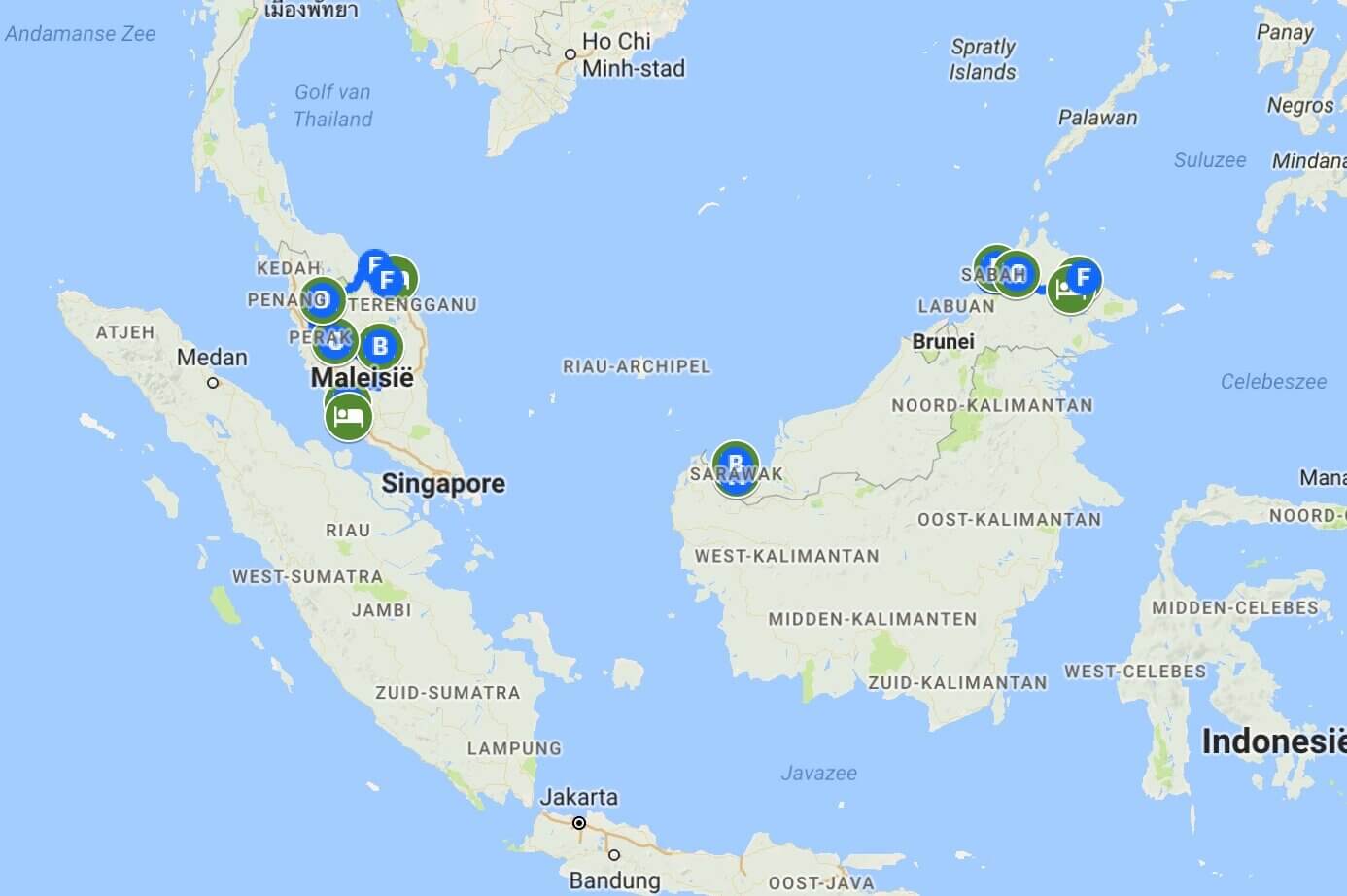
The best activities during a family tour of Malaysia with kids
Below is a summary of the best activities during a round trip through Malaysia with children.
- Playground, waterpark, and light fountains at the Petronas Towers in Kuala Lumpur.
- Canopy walk through the treetops in the Taman Negara rainforest.
- Pick tea leaves in the Cameron Highlands and try making your own tea.
- Snorkel from the beach on the Perhentian Islands — plenty of clownfish (Nemo!), and safe even for beginner swimmers.
- Count cats in Cat City, Kuching (Sarawak, Borneo).
- Sleep in a treehouse among the monkeys in Damai, Borneo.
- Eat! Enjoy delicious fruit salads, banana pancakes, noodles, roti canai, and more.
- Spot orangutans and sun bears at the world-famous Rehabilitation Centre in Sepilok, Borneo.
- Go on a jungle boat safari to Kota Kinabatangan, Borneo.

Top Things to Do per Destination
Kuala Lumpur
The busy capital! Here we’re staying in the cool apartment The Face Suites on the 48th floor with a rooftop pool. From the large windows, we have a view of the Petronas Towers and the Kuala Lumpur skyline; it’s a bit dizzying even for Kevin and Zara, who have a fear of heights.
We visit the Petronas Towers, standing at 452 meters tall and the tallest towers in the world until 2004. Nearby, there’s a water park, beautifully landscaped gardens, and a playground. We also explore the adjacent shopping center, Suria KLCC (Kuala Lumpur City Centre), which features high-end stores.
We take the monorail to the Berjaya Times Square shopping mall, which has an indoor amusement park (including a roller coaster!) in Bukit Bintang. It’s incredible how many floors this mall has! In the evening, we enjoy the colorful fountain show at the Petronas Towers.
On day two, we head to the colonial district and Merdeka Square, the square of independence after 150 years of British rule. We visit the beautiful Masjid Jamek mosque, the oldest in the city. From here, we walk along the Klang River to the botanical gardens, a vast green area in the city.
Struggling to get great photos of your kids on holiday?
With this free Family Photo Bingo, you turn it into a game! Kids get excited, and you’ll go home with spontaneous, original holiday snapshots.
👉 Print it out and take it with you – free when you sign up for the newsletter!

As a pedestrian, you’re definitely at a disadvantage in KL. It takes ages to get a green light, the traffic is chaotic, and the curbs are impossibly high. So watch out with young children! On the other hand, the monorail is a very fun way to get around.
Don’t forget to sample the delicious street food stalls, especially in the area around Jalan Alor, which is well-known for it.
Those with time can also visit the Batu Caves, just 15 minutes outside the city. There is a gigantic Hindu statue, and many monkeys can be found there.
Read the complete account of our time in Kuala Lumpur here.
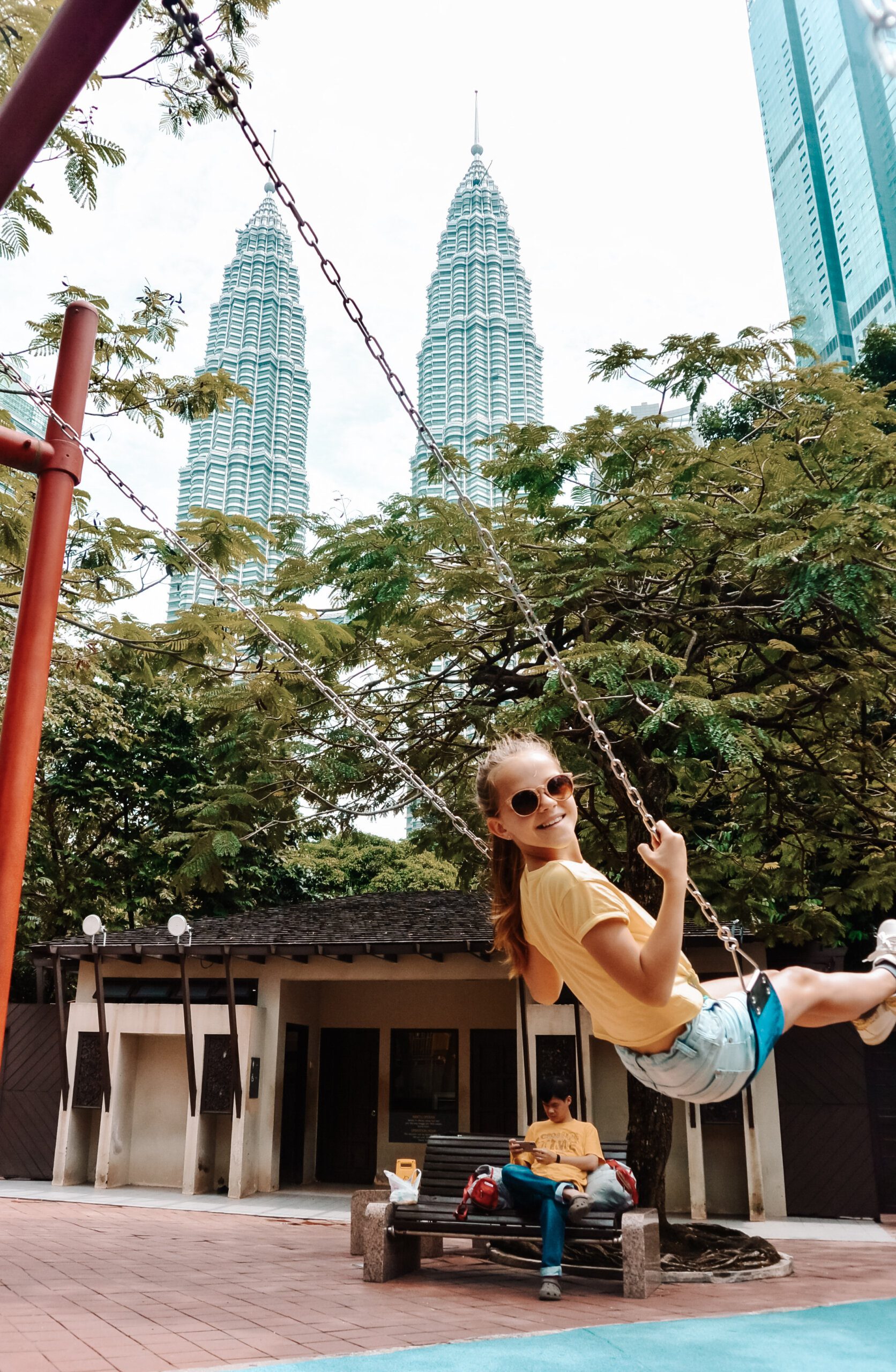
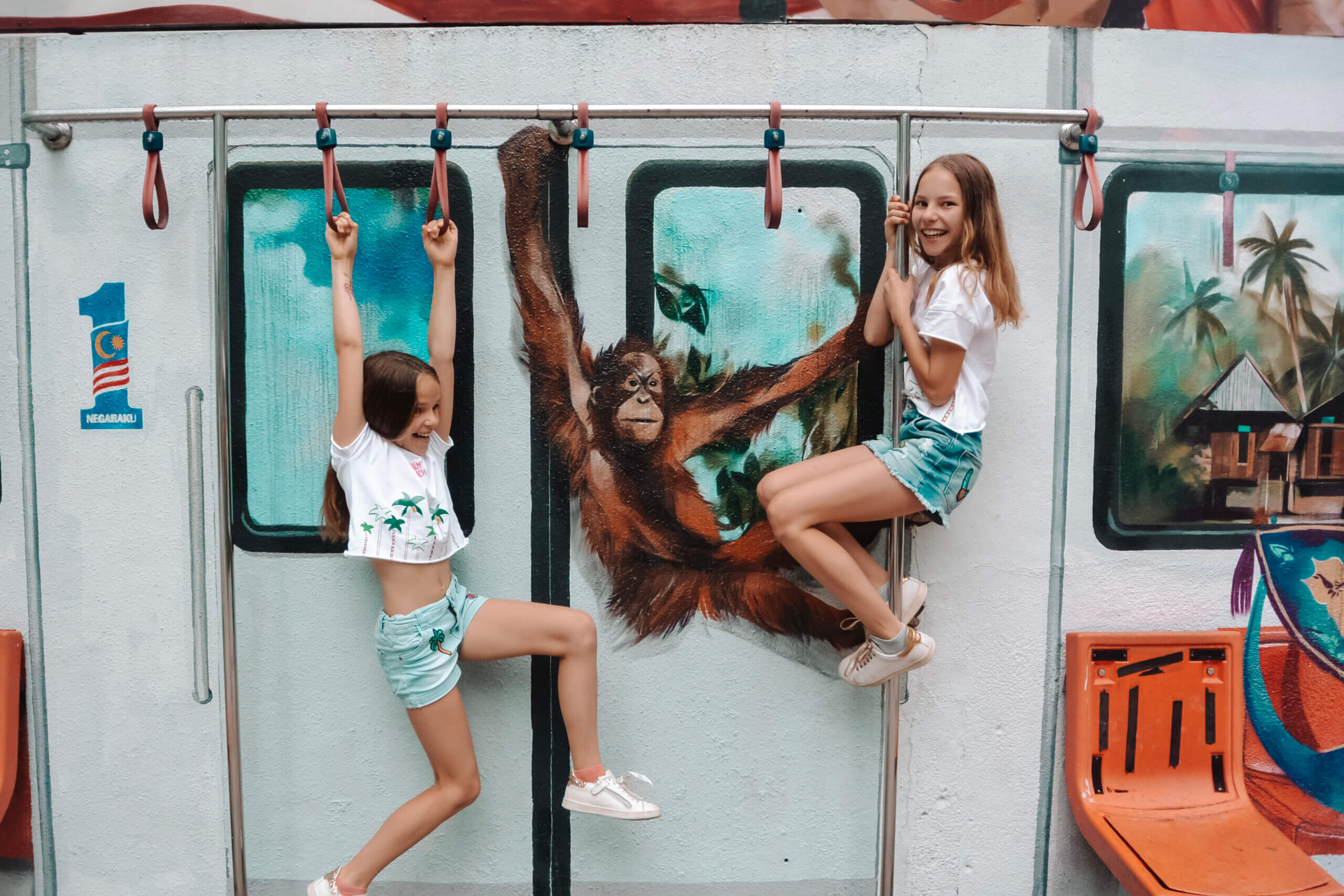
Taman Negara National Park
From the heart of downtown Kuala Lumpur, we drive the 241 km to the rainforest of Taman Negara. The drive is smooth along miles of hilly roads lined with palm forests.
The Tebing Guesthouse in Kuala Tahan is relatively new, very nice, but simple. The garden is home to various fruit types, all of which we taste.
Across the Tembeling River lies the village of Kuala Tahan, which has a few floating restaurants. The boats are atmospherically lit, creating a cozy atmosphere. The village is quite simple; we visit the school and see that the people live in a relatively primitive manner.
Taman Negara is the oldest rainforest in the world, even older than the Amazon in Latin America. The area was declared a national park in 1938 and has since become the largest national park in Malaysia. It is a primary rainforest, meaning that it has not been logged or has been logged very little, and the rainforest remains in its original state.
On Malaysian Borneo, there is much more secondary rainforest, where logging has occurred, and trees have since regrown. Taman Negara means “National Park” in Malay.
We take a beautiful boat trip on the river and stop at a lovely swimming spot.
The next day, we buy a (super cheap) permit and go hiking in the park, along with the monkeys… It even gets a bit tense when a monkey blocks the path and chases Kevin as he tries to pass it. We sweat buckets on the 7-kilometer hike to Bukit Theresek, a viewpoint at 334 meters high.
We also do the famous canopy walk between the treetops.
There are also tapirs, elephants, sun bears, wild cats, tigers, and rhinoceroses living here. However, you rarely encounter them.
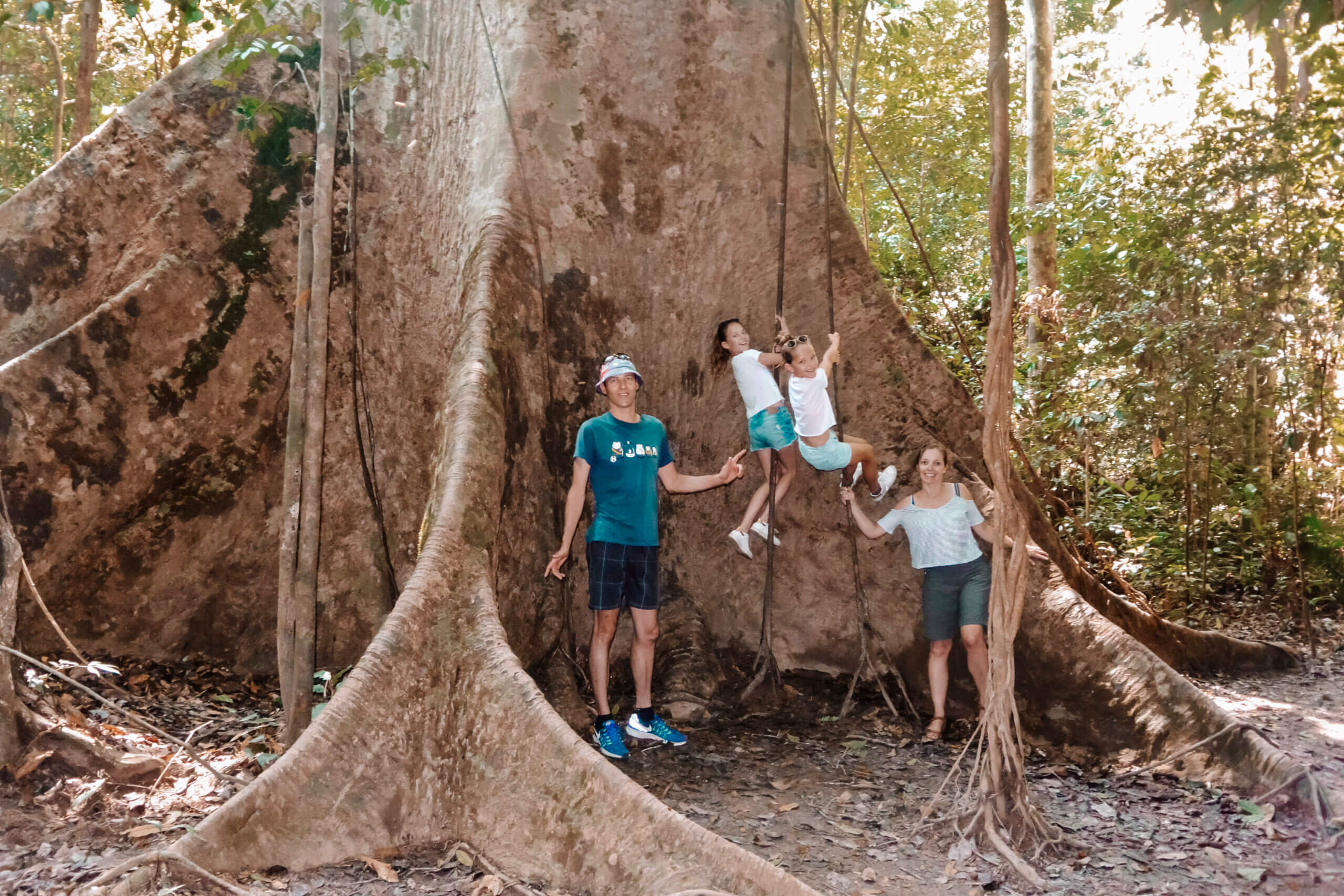
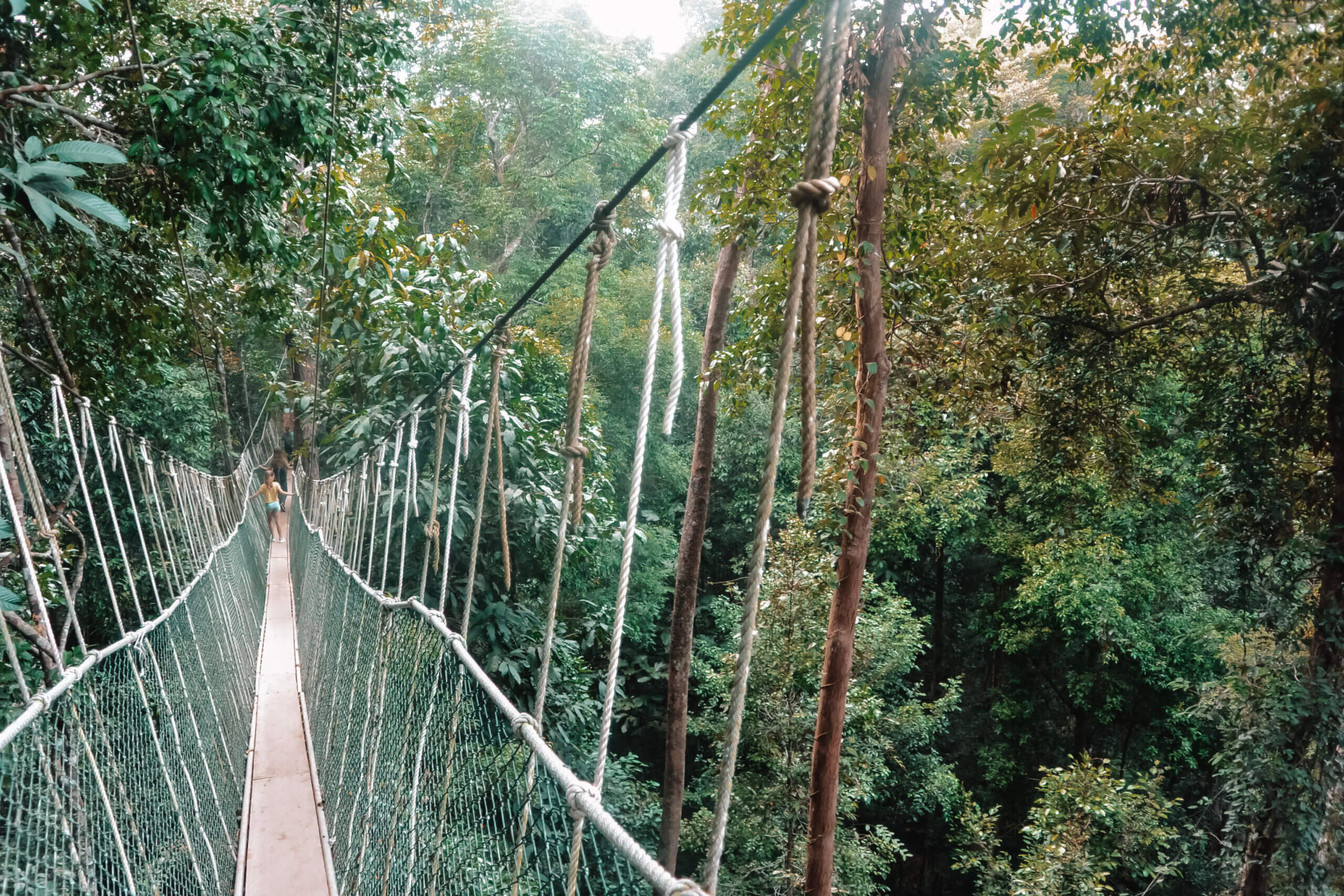
Cameron Highlands
It’s 262 kilometers from the rainforest to the Cameron Highlands. Here, we only stay for one night at the very colorful Flora Plus Hotel in Brinchang.
The Cameron Highlands is a plateau at 1,500 meters, making it a bit cooler (20-25°C). It became a popular destination among British colonists. The area is known for its tea plantations (including the Sungai Palace Boh tea plantation). You can also find many strawberry, orchid, lavender, and honey farms there.
We take a tour around the tea plantations. Of course, we sample some tea and also pick some tea leaves ourselves in the fields, which the girls later use to brew tea for us… The landscape is beautiful and so green.
We also stop at the Sam Poh Temple, a beautiful Buddhist temple, where we light a candle. The girls find this a very fascinating place.
The village of Brinchang is slightly less touristy than Tanah Rata and also a bit busier. There are various shops, markets, and local restaurants. Of course, we buy strawberries! Enna’s favorite fruit.
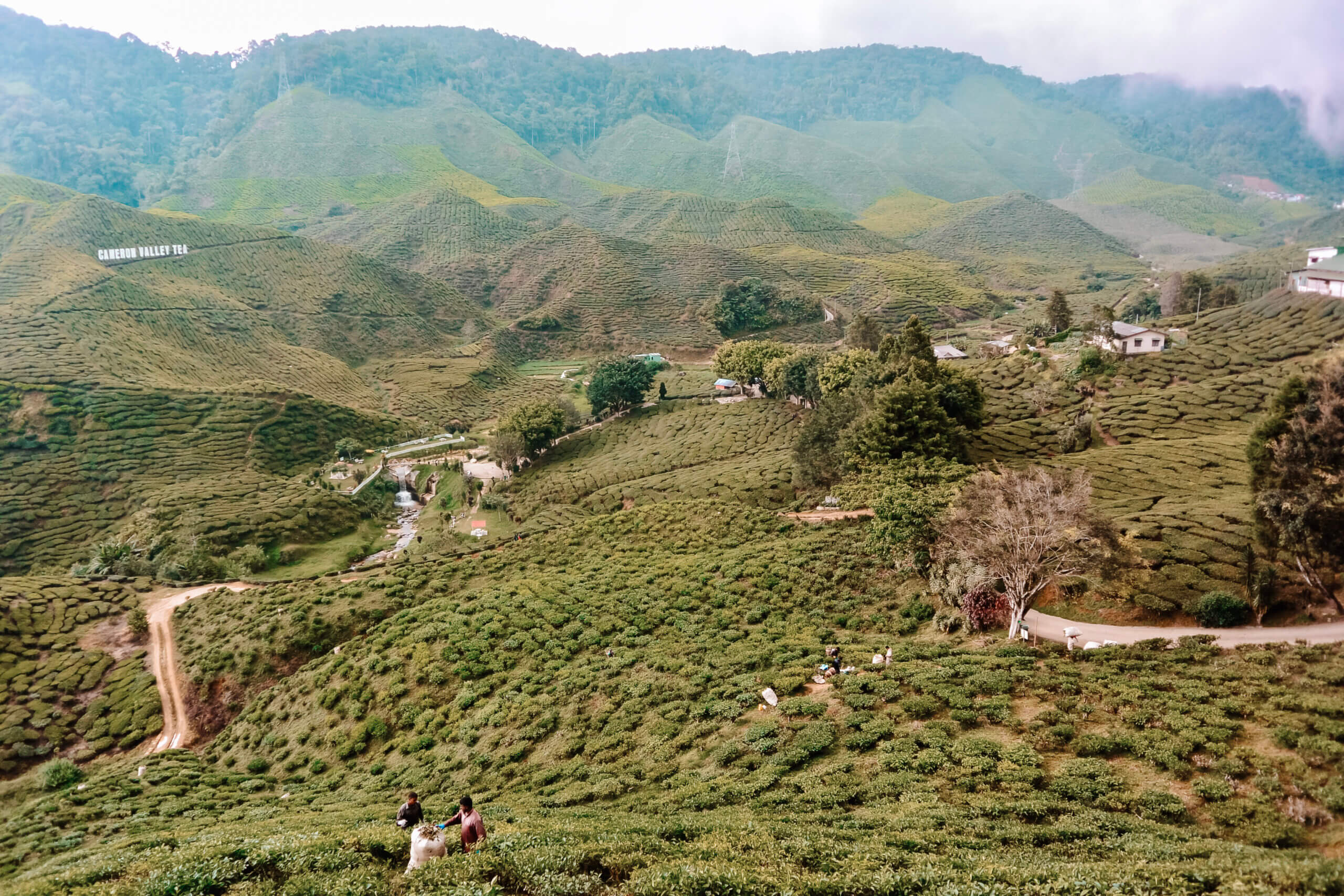
Royal Belum State Park
We head even further north to the border with Thailand, reaching Royal Belum State Park, a drive of 169 km.
Unfortunately, we only stay one night at the beautiful Belum Rainforest Resort. The room is in Balinese style with wooden floors, and there’s so much to do in the nature park. It’s really a shame that we can’t stay longer…
The girls are having a blast in the beautiful pool.
Royal Belum State Park, together with Taman Negara, is one of the oldest rainforests in the world. It is not yet an official national park, so the locals are still free to engage in logging, unfortunately. There is a huge tourism potential here. The Rainforest Resort is located by Lake Temenggor, and it is still peaceful with tourists. Guided boat tours are organized, and of course, many animals (including elephants) inhabit the area, along with the rafflesia plant, which has the largest flower in the world.
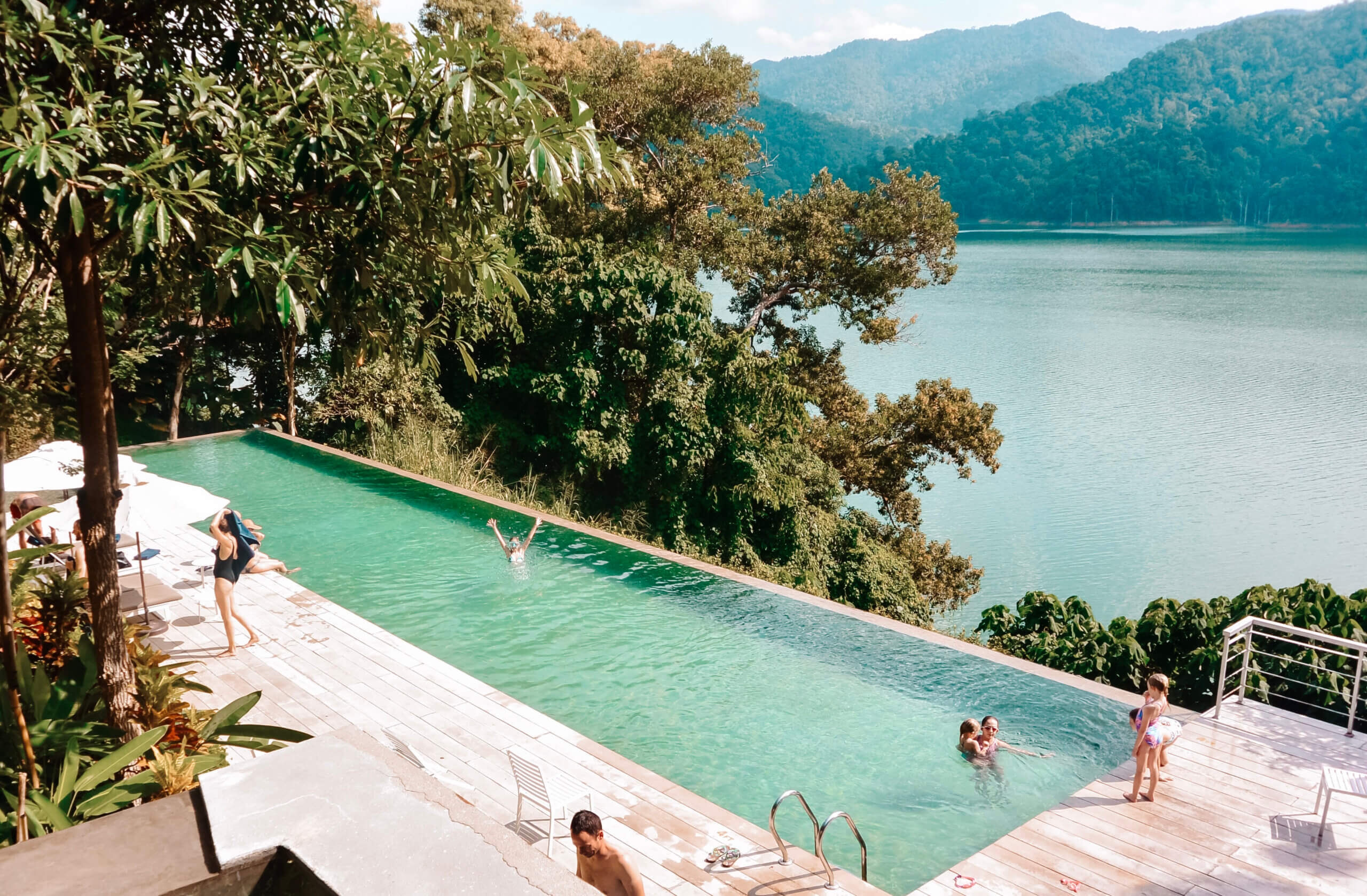
Perhentian Islands
Along the border with Thailand, we travel to Kota Bharu (183 km). We leave early because we’ve arranged a transfer to our next accommodation. The drive is very beautiful, and at the highest point (1050 m), we get a stunning view of the Titiwangsa mountain range located in Thailand.
We don’t see elephants and tapirs, but we do spot monkeys. We drive for quite a while along the border with Thailand. Crossing over is tempting, but we have to go through immigration, and we don’t have enough time.
At Kota Bharu airport, we return the rental car and have a transfer to Kuala Besut on the east coast (55 km). We just miss the large boat from our resort, so the crossing is quite bumpy in the much smaller boat. But then we see the paradise islands emerging… heavenly!
We stay for 6 nights in a seaside bungalow at Tuna Bay Resort, equipped with air conditioning but without WiFi (fortunately, there is a bit of reception at the restaurant). With a coral garden full of tropical fish right outside our door, we keep ourselves well entertained. We enjoy the tastiest freshly caught fish, curry noodles, tandoori, and roti canai.
The Perhentian Islands are an archipelago off the east coast of Malaysia. There are two islands (Besar and Kecil) with stunning beaches and fantastic diving and snorkeling spots. The atmosphere is very much that of a backpacker haven. Water taxis take you from one beach to another, and at the resort, you can book snorkeling trips on-site.
Read more about our time on these beautiful islands here.
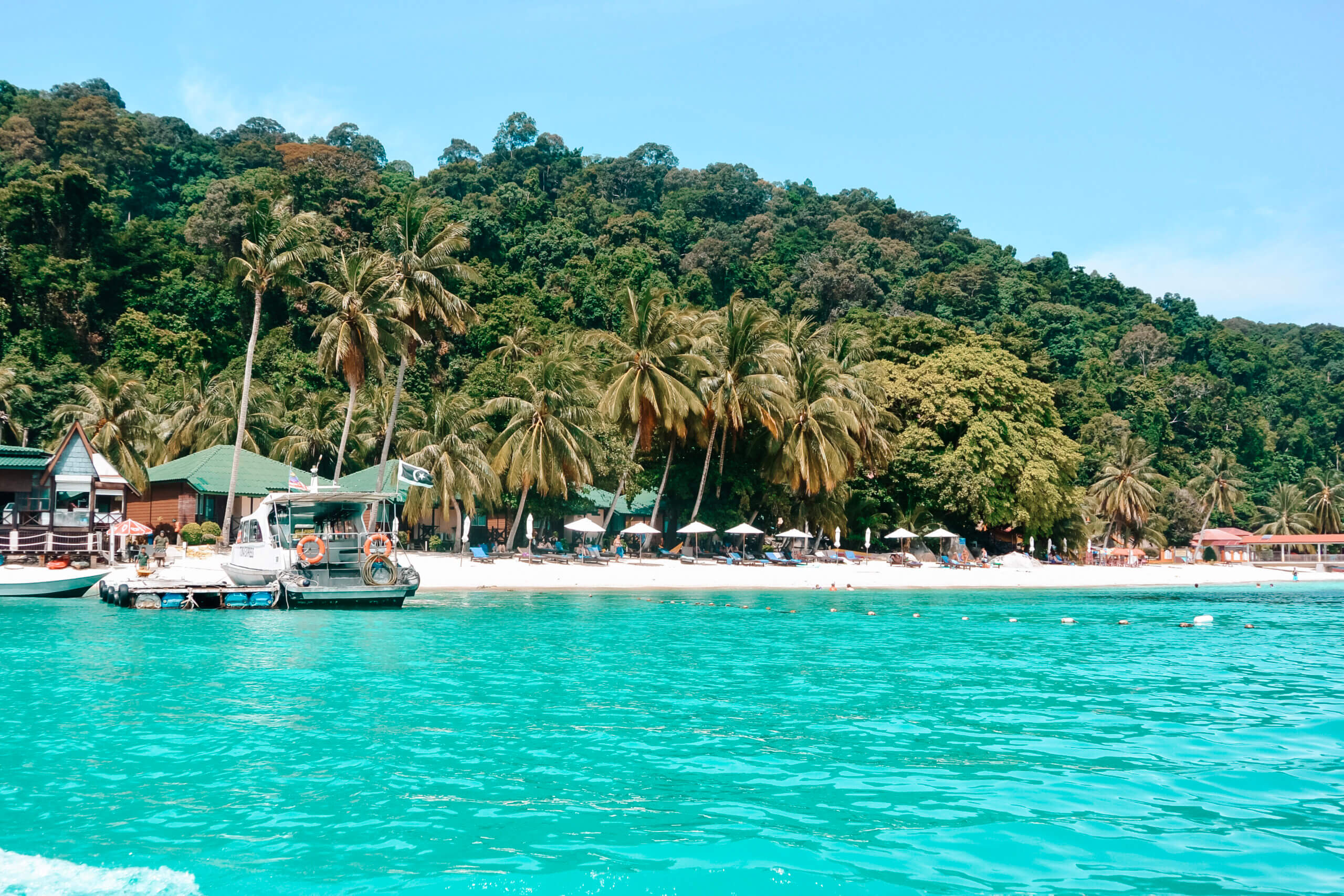
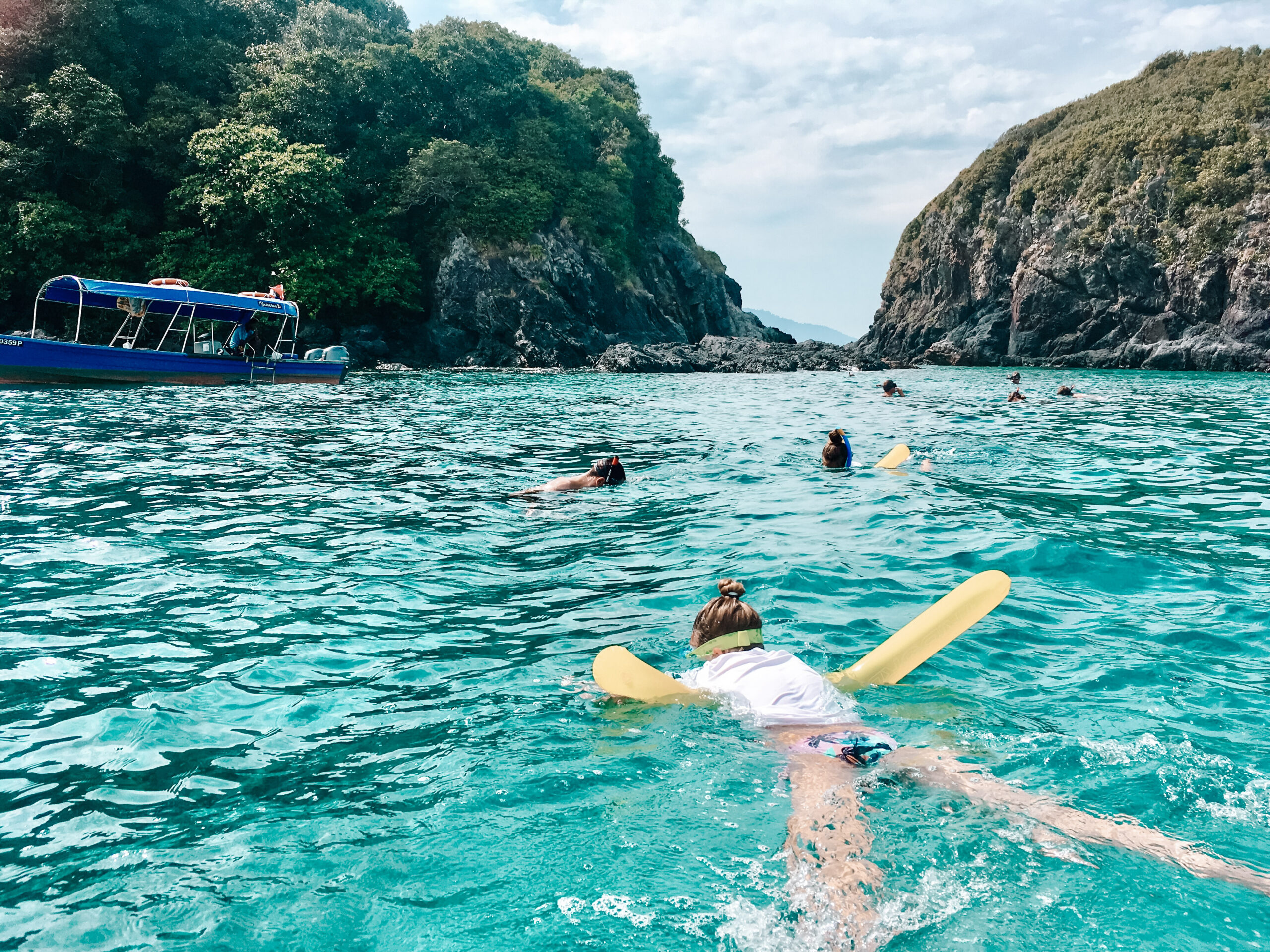
Kuching (Sarawak, Borneo)
We’re heading to Borneo! Two weeks…
First, we take the boat (thankfully the big one this time) back from Perhentian to Kuala Besut, and then we travel by minibus to Kota Bharu Airport. We have an evening flight with Air Asia to Kuching, where we’ll stay for two nights at the Merdeka Palace Hotel, a typical city hotel.
Borneo consists of a Malaysian part (Sarawak and Sabah), an Indonesian part (Kalimantan), and the small state of Brunei. Once, Borneo was entirely covered with tropical rainforest, but over 80% has disappeared, cleared for palm oil plantations.
Kuching, or “Cat City,” is the largest city in Sarawak, with a population of 617,000. The cat is the city’s symbol, and we see statues and drawings of cats everywhere. The Sarawak River flows through this modern city, which has a Chinese feel to it.
We take a city walk and find it surprisingly relaxing and peaceful. The Kuching Waterfront is a lovely place to spend time, with many food stalls. We attract quite a bit of attention, and the girls are often asked for selfies by local Muslim women. Kuching is very colorful. We do some shopping and visit Chinatown.
Nearby, you can visit an orangutan reserve (Semenggoh), but we’ll do that later in Sabah.
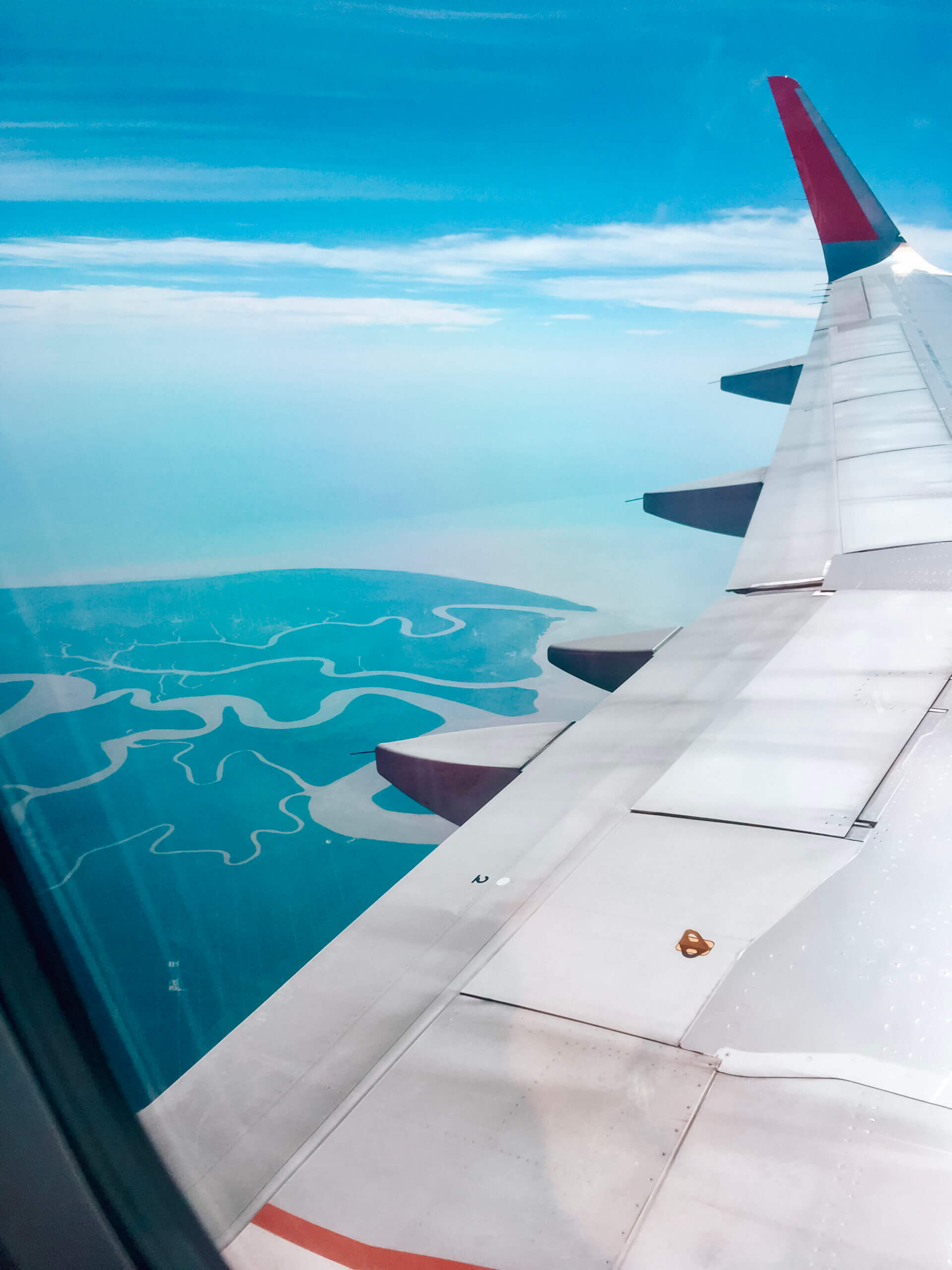
Permai Rainforest Resort, Damai Beach
From the city, it’s not far to the jungle, where we will spend 3 nights staying in a treehouse! The Permai Rainforest Resort is located in Damai by the sea. The treehouse has air conditioning, and the monkeys keep us company in the treetops.
Damai is located north of Kuching along the South China Sea. Here, you can find the Sarawak Cultural Village and various food stalls. There are plenty of activities to enjoy at this eco-resort: SUP (stand-up paddleboarding), sea kayaking, and boat excursions to the mangroves, among others.
We are going on an excursion to Bako National Park, and instead of taking the road, we go by boat. It’s quite bumpy and at times rather exciting on the somewhat rough sea. For our daughters, this will turn out to be the most fun part of the trip…
One of the main reasons to visit Bako is the chance to see the highly endangered proboscis monkey up close. There are also several other monkey species in the nature park, such as the silvered-leaf monkey. You’ll also find plenty of ‘common’ long-tailed macaques. These are generally considered less cute, and we experienced that firsthand. They just snatch the food right out of your backpack!
Another unique feature of Bako National Park is the variety of ecosystems that can be found in the park: beach vegetation, cliffs, heath forests, mangrove forests, and peat swamp forests. We hike through it in extreme humidity and heat, only to encounter the cheeky macaques. The guide (me, of course) didn’t earn any points for this trip!
The next day, we spot the proboscis monkeys and silvered-leaf monkeys right from the treehouse! Amazing!
We also take a boat trip to the Kuching wetlands in search of Irrawaddy dolphins (which we see in abundance), crocodiles, and turtles.
Finally, we also visit the Sarawak Cultural Village, which is located near the resort. Enna learns to shoot with a blowpipe, and we get to see how people traditionally lived in this part of Borneo.
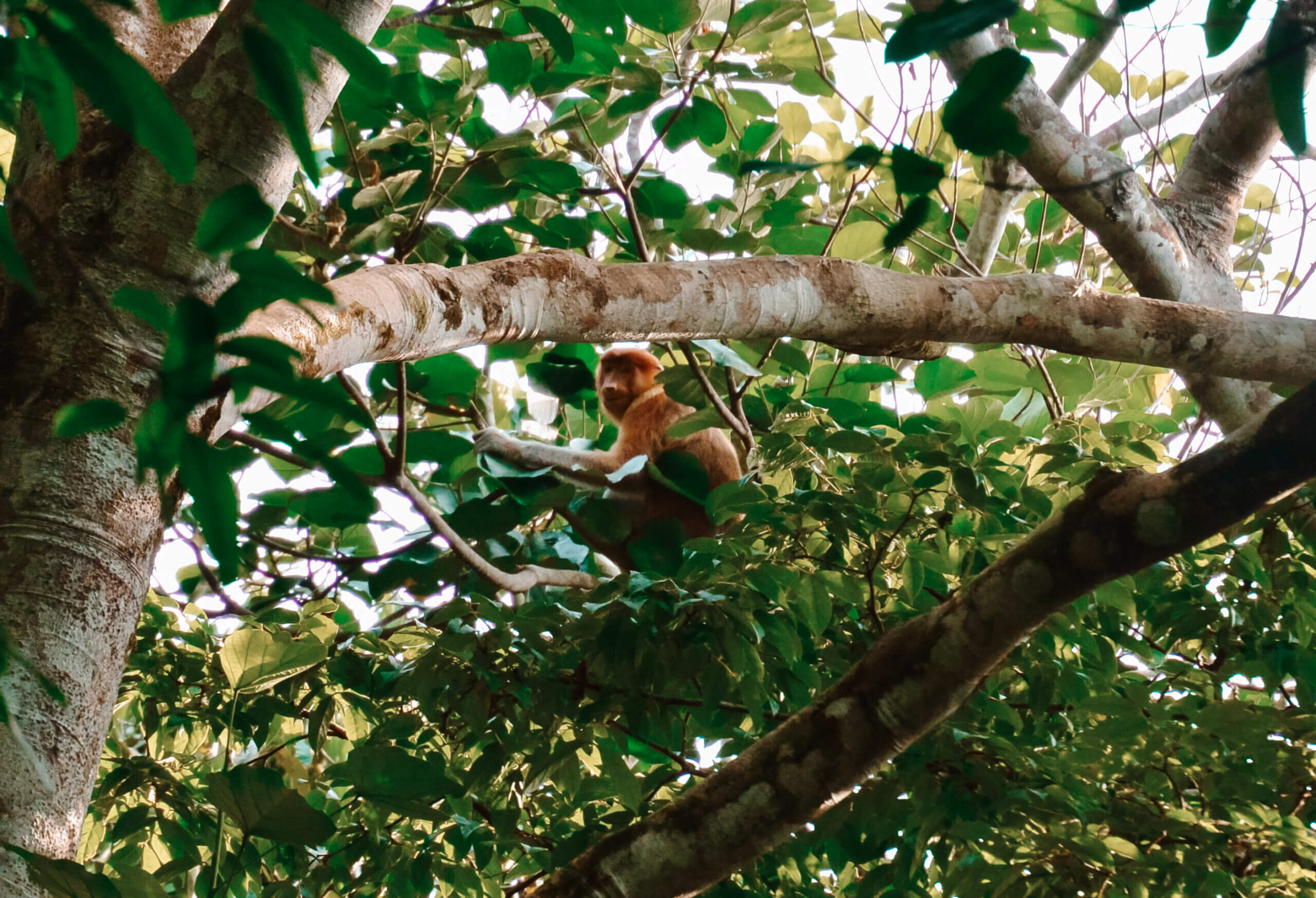
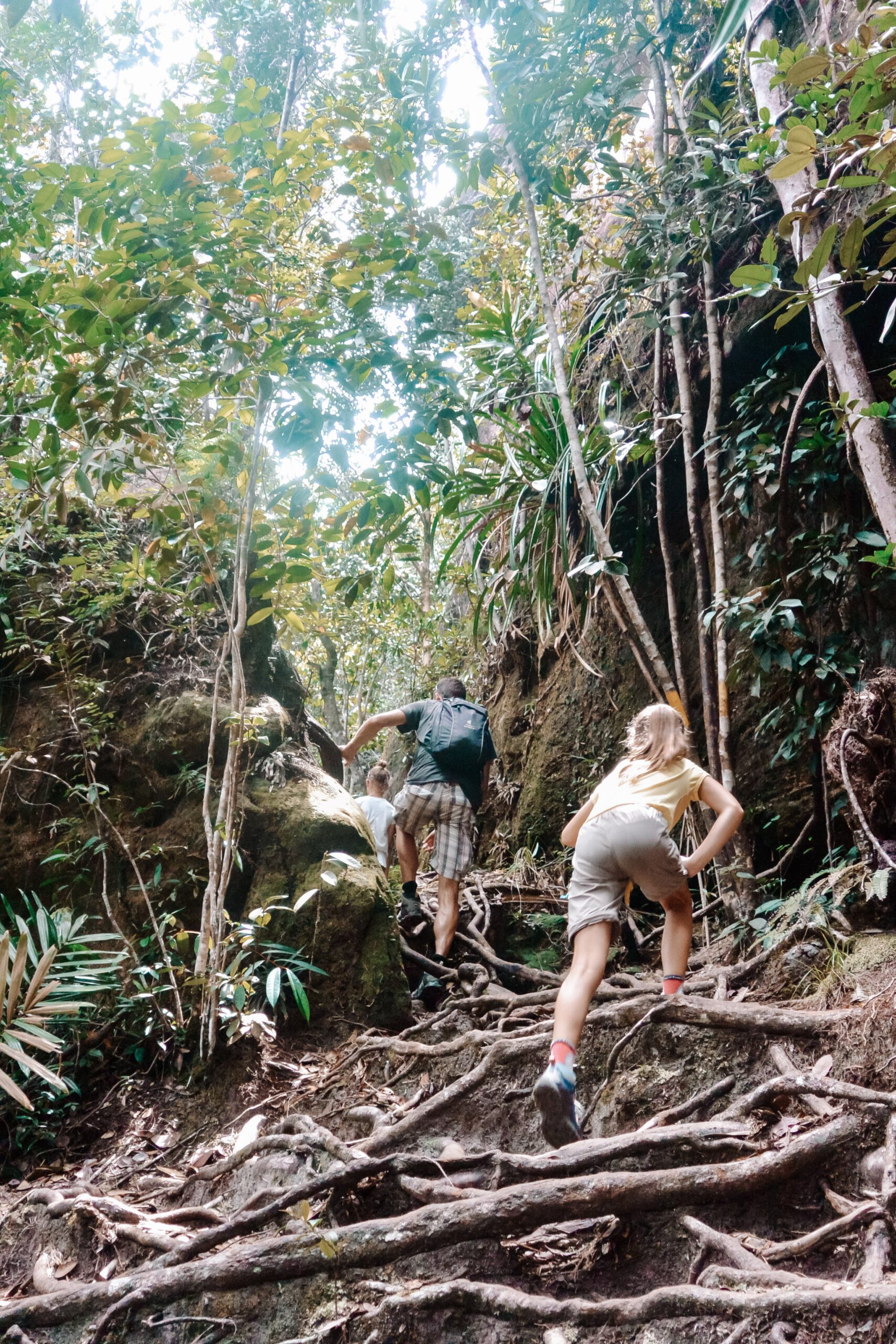
Kota Kinabalu (Sabah, Borneo)
We fly to the other side of Borneo, from Kuching to Kota Kinabalu. The view of Borneo’s rivers from the air is stunning. We pick up the new rental car, a Proton Saga, made in Malaysia! Solid, but very basic…
We follow Google Maps to Sabah Beach Villas, in Karambunai, near Kota Kinabalu.
Kota Kinabalu is the capital of Sabah, in East Borneo, and has over 300,000 inhabitants. We spend most of our days here on the beach and by the beautiful pool. There’s a nice bar with a grill restaurant at the nearby Nexus Resort, which we enjoy visiting. What strikes us in Borneo is how calm it is in terms of tourism. The large resorts are barely filled…
We also take a sunset boat trip in the Tunku Abdul Rahman Marine Park (also a beautiful spot for snorkeling!) and sail past a Filipino gypsy village, a stilt village on the sea. We are the only ones on board and enjoy a private tour with a phenomenal sunset.
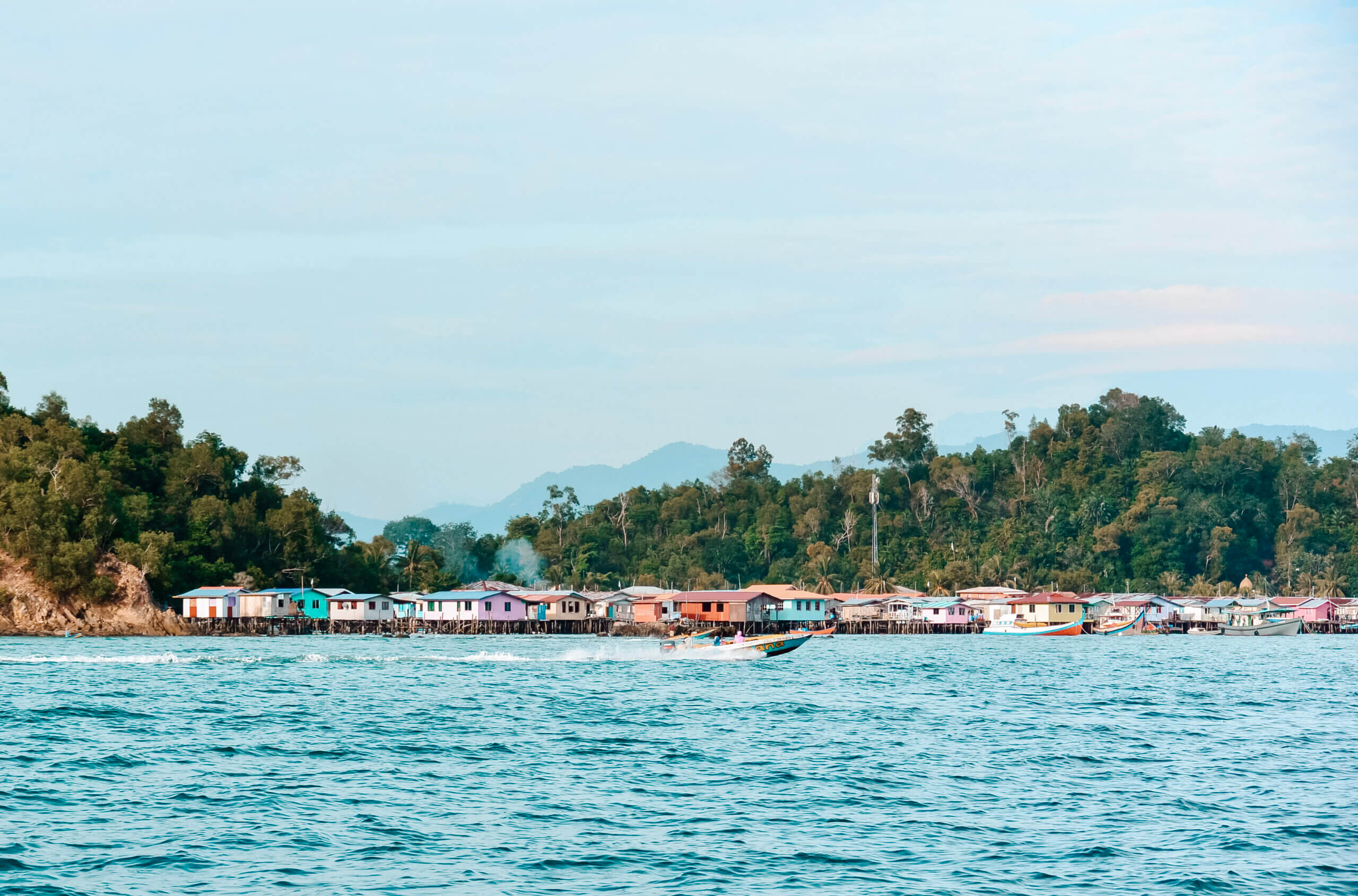
Kundasang – Mount Kinabalu
Done with the beach, we drive east towards Mount Kinabalu and Kundasang (92 km). We are now in the far north of Borneo, and the Philippines are nearby.
We spend one night by the mountain, at a homestay, Suang Noh Homestay, near the town of Kundasang. We have dinner there for just €1.50 per person! Really!
Mount Kinabalu is the highest mountain in Borneo (4,095 m), and the surrounding nature park is listed as a UNESCO World Heritage site. The village of Kundasang is located 5 km from the main entrance, at an altitude of 1,500 m. There are several (short) hiking trails and a botanical garden. We visit it, but unfortunately, there are no blooming plants… Climbing Mount Kinabalu takes two days and is said to be quite challenging.
The Poring Hot Springs, a bit further on, with waterfalls and a hanging bridge, are not as idyllic as expected. The springs are commercially operated, which is a big difference from the hot springs in Northern Australia. Still, the little pool in the warm spring water is lovely, and we enjoy it afterward with a huge fruit salad.
There is also an Anzac War Memorial, honoring 2,400 British and Australians who fell here during World War II.
Sepilok – Jungle safari Uncle Tan
The drive to Sepilok, near Sandakan, is long, 240 km, but so beautiful, through stunning tropical jungle followed by endless palm oil plantations. We call along the way and can drop off the rental car at the Sepilok Jungle Resort instead of at the Sandakan airport. Convenient!
In Sepilok is the famous orangutan rehabilitation center, opened in 1964. Here, neglected orangutans and orphans are cared for and then reintroduced to the wild. Most of the animals live in semi-freedom. It’s wonderful to see these creatures up close in their natural habitat.
Equally worth visiting is the nearby sun bear (Asian honey bear) sanctuary. In Southeast Asia, these bears are still too often kept in cages. Their bile is harvested because it is believed to have medicinal properties. In this Conservation Centre, the animals can recover. We are very impressed; it’s definitely a must-see!
From Sepilok, our 3-day jungle safari adventure to the Uncle Tan jungle camp begins. Lonely Planet has high praise for this boat safari, so expectations are high.
It’s another hour and a half drive to Kota Kinabatangan, a small, primitive village located along the river of the same name. Along the river, you have the best chance of spotting wildlife. Ecotourism is increasingly being developed here.
It becomes an amazing experience! Our group is relatively small, with about 15 fellow travelers from around the world. The camp is very basic; we sleep in an open hut with a mosquito net. We have to store our belongings in barrels because the monkeys have free rein otherwise. We really enjoyed the relaxed atmosphere in the camp, and the guides are fantastic. We go on several boat trips in the early morning and late evening. We also take hikes in the forest, and the guides engage our daughters immensely with nature.
Of course, there are more expensive alternatives for those who want more luxury.
We see orangutans, a gibbon, proboscis monkeys, macaques, monitor lizards, civet cats, hornbills, kingfishers, crocodiles, and so much more.
After the safari, we spend another night at the Sepilok Jungle Resort after leaving the jungle camp. A shower is very welcome. We treat ourselves to a delicious meal at the restaurant of the nearby Nature Resort Sepilok. It looks beautiful here for an overnight stay as well!
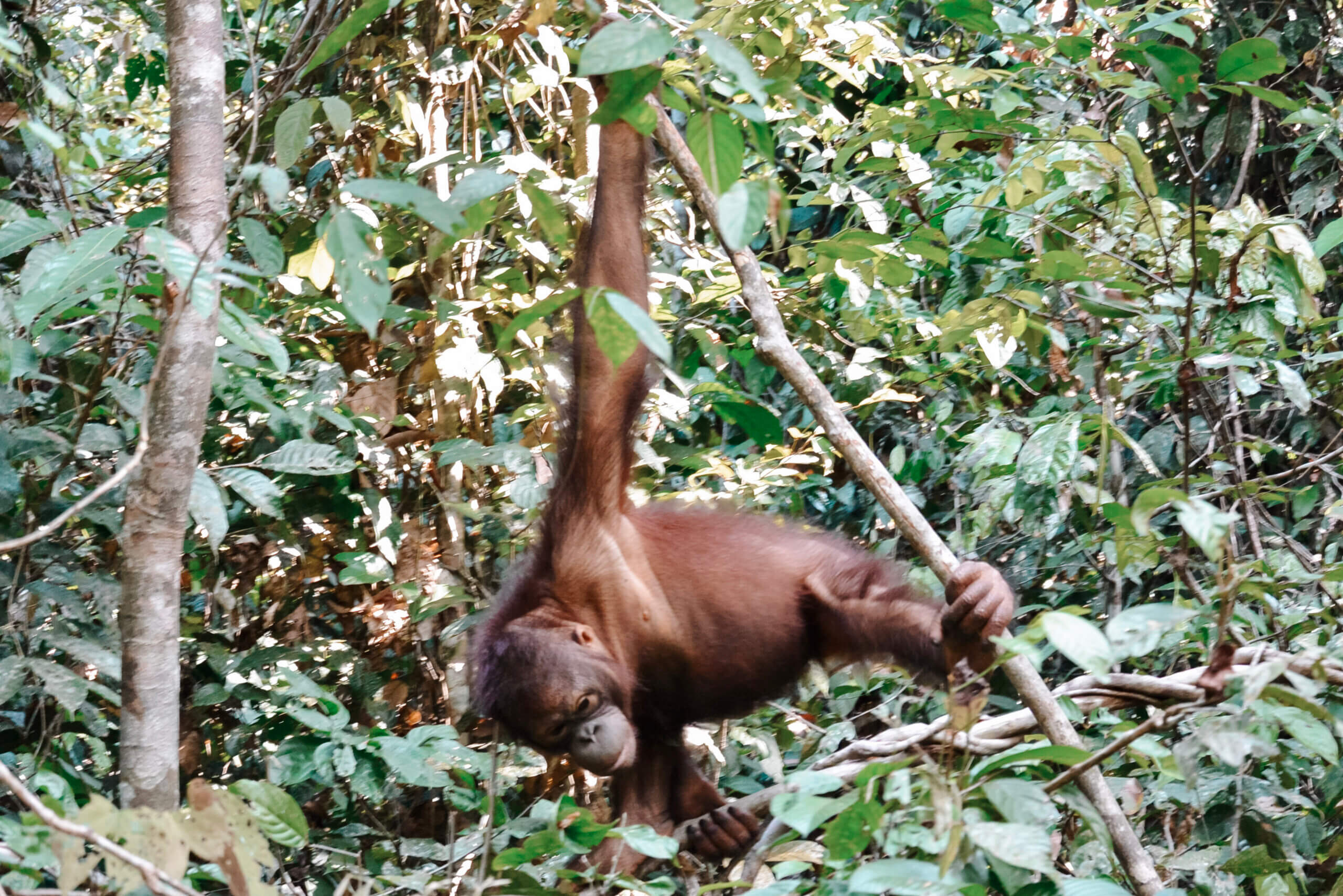
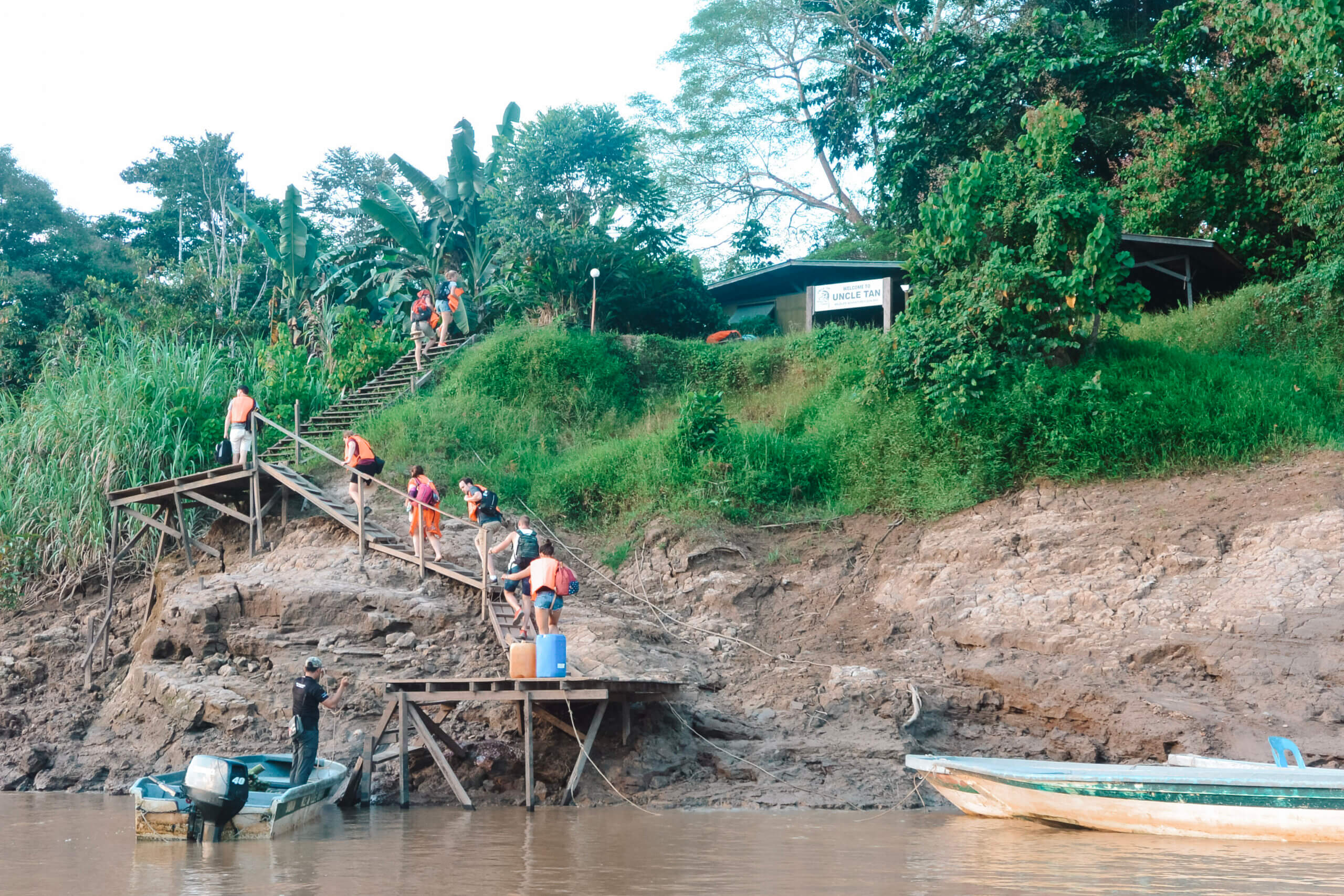
Round Trip in Malaysia with Children – Conclusion
We fly back via Sandakan to Kuala Lumpur and spend one last night in Malaysia, near the airport. The next morning, we fly back to Amsterdam via Hong Kong. We arranged a layover in Hong Kong, giving us a day to explore the city. You can read about that here: Hong Kong
We found the Malaysians to be very kind and punctual people. In terms of nature, the mainland pleasantly surprised us. There was a lot of greenery, and driving there was delightful. Borneo, on the other hand, was busier than expected. There are still beautiful rainforests, but unfortunately, much of the natural landscape has had to make way for cities and plantations. It was a privilege to see so many wild animals in their natural habitat.
Terima Kasih Malyasia! (Thank you)
About Stephanie
Hi,
Met4opreis, that’s me, Stephanie, my husband, and our two daughters, Zara and Enna. We live in Belgium. I love nothing more than planning trips and road trips, with schedules and to-do lists and all .
As a family, we have made several round trips in Australia, including a six-week adventure by jeep along the west coast when the girls were 3 and 5 years old. The New Year’s Eve fireworks show in Sydney Harbour is one of our most beautiful memories ever.
We especially love nature and have done a lot of camping, both in northern Europe (Norway and Sweden) and the south. The islands of the Mediterranean have also stolen our hearts, with Corsica and Sardinia being our favorites.
Not far from Nice, France, we have our second home… so we know the Côte d’Azur and its surroundings inside and out.
This summer (2023), we are going to Africa for the first time for a road trip through northern Namibia and Botswana. Our adventures will definitely be shared on Instagram.
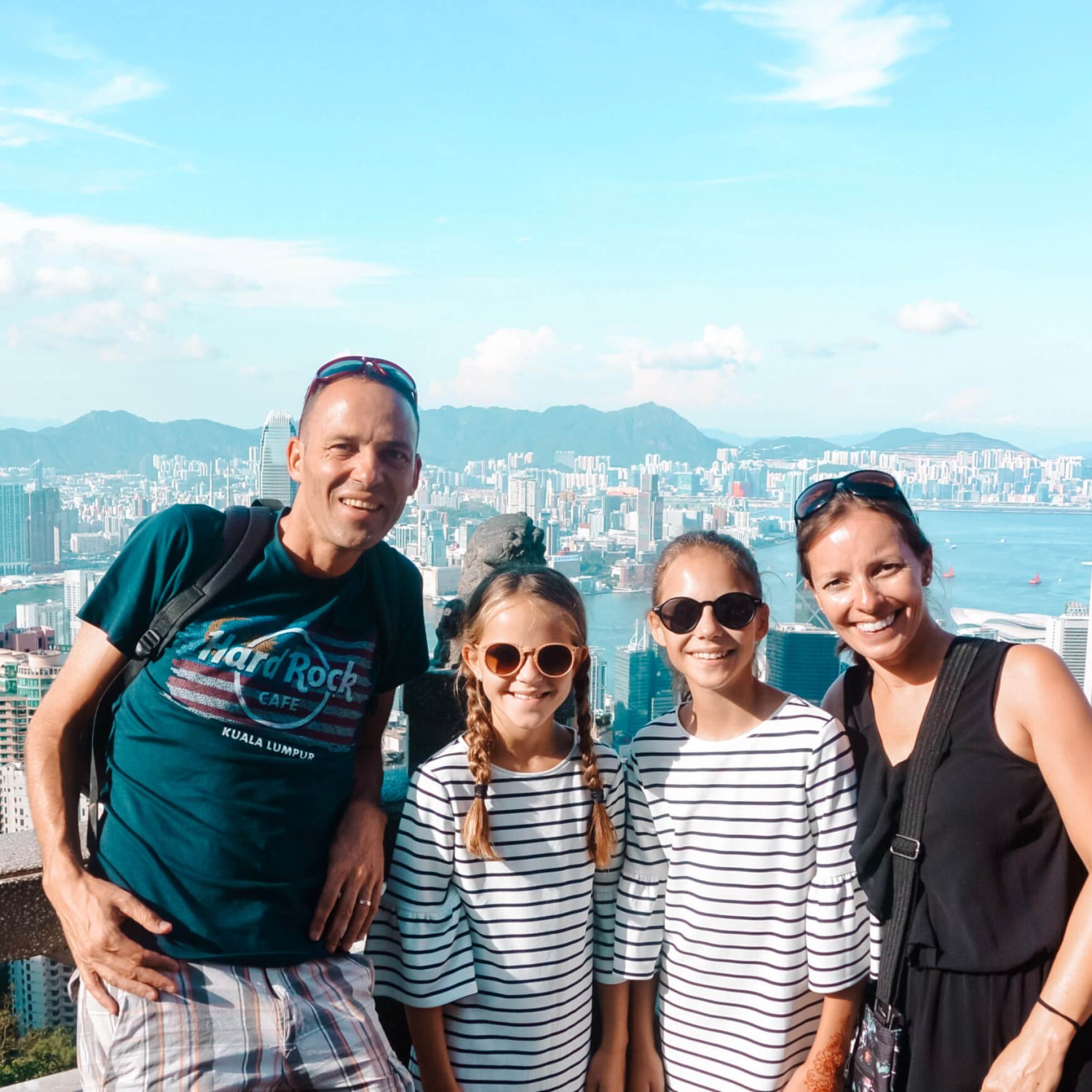
Follow Stephanie on Instagram @stephanie_vermaut and read all about her adventures on her blog www.met4opreis.be
Book Your Trip to MALAYSIA with Kids
Booking.com , you can easily find child-friendly accommodations in Malaysia, and the cheapest flights can be found on Skyscanner. For fun excursions, boat trips, and activities, check out GetYourGuide.com , and you can conveniently rent a car through Sunny Cars.
Still exploring options for a family-friendly holiday? On our homepage, you’ll find an overview of popular destinations for families.
